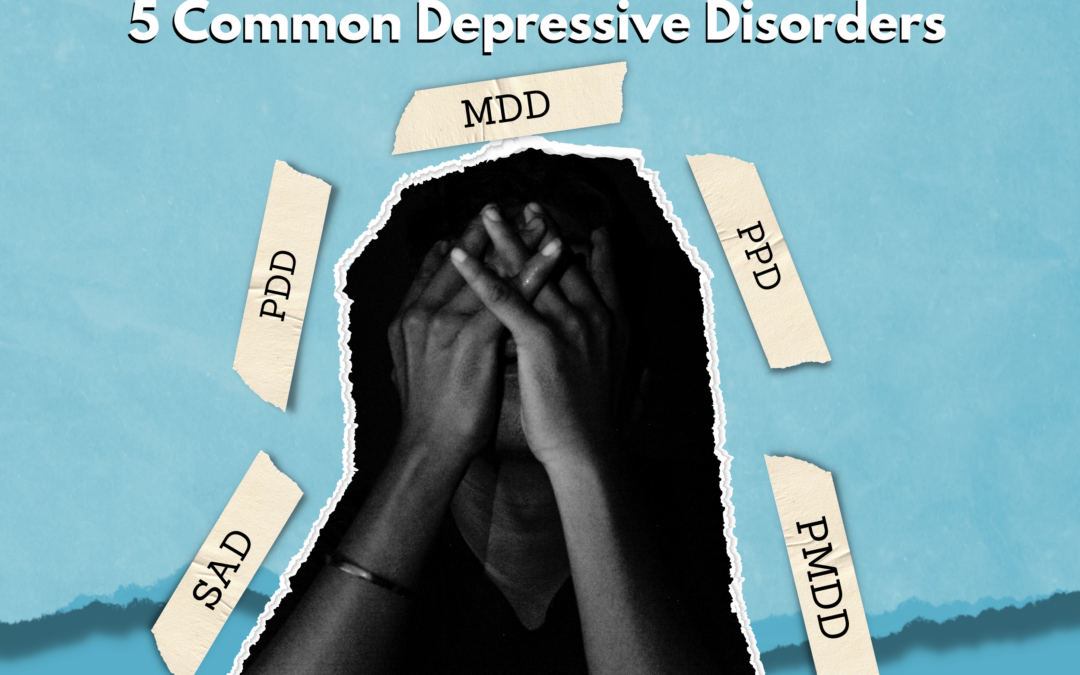Depression is a complex and widespread mental health condition that affects millions of people worldwide. While we often use the term “depression” as a general descriptor, it’s important to recognize that depression can manifest in various forms. In this blog post, we will delve into five distinct types of depression: Major Depressive Disorder (MDD), Persistent Depressive Disorder (PDD), Seasonal Affective Disorder (SAD), Postpartum Depression (PMDD), and Premenstrual Dysphoric Disorder. Understanding these different forms can help us gain insight into their unique characteristics, causes, and potential treatments.
1. Major Depressive Disorder
Major Depressive Disorder, commonly known as MDD or clinical depression, is one of the most prevalent forms of depression. It is characterized by persistent feelings of sadness, hopelessness, and a loss of interest or pleasure in activities. MDD can occur in episodes, with each episode lasting for at least two weeks. The frequency and intensity of episodes can vary from person to person, and the disorder can significantly impact daily functioning, relationships, and overall quality of life. Symptoms may include changes in appetite and weight, sleep disturbances, low energy levels, difficulty concentrating, and recurrent thoughts of death or suicide.
2. Persistent Depressive Disorder
Persistent Depressive Disorder, also known as PDD or dysthymia, is a chronic form of depression that lasts for a prolonged period, typically two years or longer. Unlike MDD, PDD is characterized by milder symptoms that persist for an extended duration. People with PDD often experience a persistent feeling of sadness or low mood, accompanied by other symptoms such as changes in appetite, low self-esteem, difficulty making decisions, and a lack of energy. PDD can be challenging to diagnose, as the symptoms may be less severe and, as a result, people may not seek treatment. However, it is important to recognize and address PDD, as it can significantly impact a person’s mental health and ability to function optimally.
3. Seasonal Affective Disorder
Seasonal Affective Disorder, or SAD, is a type of mood disorder that is characterized by recurrent episodes of depression that occur during specific seasons, typically during the fall and winter months. It is sometimes referred to as “winter depression” or “winter blues.” Common symptoms of SAD include persistent feelings of sadness, hopelessness, and low mood, decreased energy levels, difficulty concentrating, changes in appetite and weight (often with cravings for carbohydrates), increased need for sleep, social withdrawal, and a loss of interest in activities previously enjoyed. These symptoms tend to be more pronounced during the winter months and improve with the arrival of spring or summer. The exact cause of SAD is not known, but it is believed to be related to changes in the body’s internal clock and a reduction in sunlight exposure during the shorter days of winter. The reduced sunlight can disrupt the body’s circadian rhythm and affect the production of certain brain chemicals, such as serotonin, which play a role in mood regulation. While SAD is most commonly associated with the winter season, a less common form called “summer-onset SAD” occurs when people experience depressive episodes during the spring and summer months. Symptoms of summer-onset SAD may include insomnia, agitation, restlessness, anxiety, decreased appetite, and weight loss.
4. Postpartum Depression
Postpartum Depression, often abbreviated as PPD, is a specific type of depression that affects parents after childbirth. It is common for new parents to experience mood swings, tearfulness, and exhaustion after having a baby, often referred to as the “baby blues.” However, when these symptoms persist and intensify, it may indicate the presence of PPD. PPD can manifest within the first few weeks after delivery or even months later, and it can interfere with a parent’s ability to care for themself and their child. Symptoms may include feelings of sadness, anxiety, irritability, changes in appetite and sleep patterns, difficulty bonding with the baby, and even thoughts of harming oneself or the baby.
5. Premenstrual Dysphoric Disorder
Premenstrual Dysphoric Disorder (PMDD) is a severe and debilitating form of premenstrual syndrome (PMS) that affects a small percentage of women who menstruate. PMDD is characterized by intense emotional and physical symptoms that occur in the week or two leading up to the onset of menstruation and significantly impact daily functioning and quality of life. While many people experience mild mood changes or physical discomfort in the days preceding their menstrual cycle, PMDD involves more severe and disruptive symptoms. These symptoms typically subside within a few days after menstruation begins.
The exact cause of PMDD is not fully understood, but it is believed to be related to the hormonal fluctuations that occur during the menstrual cycle. Hormonal changes, particularly in serotonin levels, may contribute to the development of PMDD.
In Summary
Depression is a multifaceted mental health condition that can manifest in various forms, each with its unique characteristics, causes, and treatment approaches. Major Depressive Disorder (MDD), Persistent Depressive Disorder (PDD), Seasonal Affective Disorder (SAD), Postpartum Depression (PPD), and Premenstrual Dysphoric Disorder (PMDD) all represent distinct variations of depression, highlighting the importance of personalized assessment and care.


Recent Comments